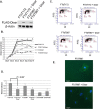Epithelialization of mouse ovarian tumor cells originating in the fallopian tube stroma
- PMID: 27602775
- PMCID: PMC5323216
- DOI: 10.18632/oncotarget.11808
Epithelialization of mouse ovarian tumor cells originating in the fallopian tube stroma
Abstract
Epithelial ovarian carcinoma accounts for 90% of all ovarian cancer and is the most deadly gynecologic malignancy. Recent studies have suggested that fallopian tube fimbriae can be the origin of cells for high-grade serous subtype of epithelial ovarian carcinoma (HGSOC). A mouse HGSOC model with conditional Dicer-Pten double knockout (Dicer-Pten DKO) developed primary tumors, intriguingly, from the fallopian tube stroma. We examined the growth and epithelial phenotypes of the Dicer-Pten DKO mouse tumor cells contributable by each gene knockout. Unlike human ovarian epithelial cancer cells that expressed full-length E-cadherin, the Dicer-Pten DKO stromal tumor cells expressed cleaved E-cadherin fragments and metalloproteinase 2, a mixture of epithelial and mesenchymal markers. Although the Dicer-Pten DKO tumor cells lost the expression of mature microRNAs as expected, they showed high levels of tRNA fragment expression and enhanced AKT activation due to the loss of PTEN function. Introduction of a Dicer1-expressing construct into the DKO mouse tumor cells significantly reduced DNA synthesis and the cell growth rate, with concurrent diminished adhesion and ZO1 epithelial staining. Hence, it is likely that the loss of Dicer promoted mesenchymal-epithelial transition in fallopian tube stromal cells, and in conjunction with Pten loss, further promoted cell proliferation and epithelial-like tumorigenesis.
Keywords: fallopian tube; ovarian cancer.
Conflict of interest statement
The authors have no potential conflicts of interest to disclose.
Figures




Similar articles
-
High-grade serous ovarian cancer arises from fallopian tube in a mouse model.Proc Natl Acad Sci U S A. 2012 Mar 6;109(10):3921-6. doi: 10.1073/pnas.1117135109. Epub 2012 Feb 13. Proc Natl Acad Sci U S A. 2012. PMID: 22331912 Free PMC article.
-
Functional analysis of miR-34c as a putative tumor suppressor in high-grade serous ovarian cancer.Biol Reprod. 2014 Nov;91(5):113. doi: 10.1095/biolreprod.114.121988. Epub 2014 Oct 1. Biol Reprod. 2014. PMID: 25273528 Free PMC article.
-
[Significance and expression of PAX8, PAX2, p53 and RAS in ovary and fallopian tubes to origin of ovarian high grade serous carcinoma].Zhonghua Fu Chan Ke Za Zhi. 2017 Oct 25;52(10):687-696. doi: 10.3760/cma.j.issn.0529-567X.2017.10.008. Zhonghua Fu Chan Ke Za Zhi. 2017. PMID: 29060967 Chinese.
-
Ovarian serous carcinogenesis from tubal secretory cells.Histol Histopathol. 2015 Nov;30(11):1295-302. doi: 10.14670/HH-11-645. Epub 2015 Jul 15. Histol Histopathol. 2015. PMID: 26174492 Review.
-
Exploring the Role of Fallopian Ciliated Cells in the Pathogenesis of High-Grade Serous Ovarian Cancer.Int J Mol Sci. 2018 Aug 24;19(9):2512. doi: 10.3390/ijms19092512. Int J Mol Sci. 2018. PMID: 30149579 Free PMC article. Review.
Cited by
-
Characterization of MicroRNA-200 pathway in ovarian cancer and serous intraepithelial carcinoma of fallopian tube.BMC Cancer. 2017 Jun 17;17(1):422. doi: 10.1186/s12885-017-3417-z. BMC Cancer. 2017. PMID: 28623900 Free PMC article.
-
In Vivo Cell Fate Tracing Provides No Evidence for Mesenchymal to Epithelial Transition in Adult Fallopian Tube and Uterus.Cell Rep. 2020 May 12;31(6):107631. doi: 10.1016/j.celrep.2020.107631. Cell Rep. 2020. PMID: 32402291 Free PMC article.
-
MicroRNA-200 family governs ovarian inclusion cyst formation and mode of ovarian cancer spread.Oncogene. 2020 May;39(20):4045-4060. doi: 10.1038/s41388-020-1264-x. Epub 2020 Mar 25. Oncogene. 2020. PMID: 32214198
-
A dog oviduct-on-a-chip model of serous tubal intraepithelial carcinoma.Sci Rep. 2020 Jan 31;10(1):1575. doi: 10.1038/s41598-020-58507-4. Sci Rep. 2020. PMID: 32005926 Free PMC article.
-
The Functions of MicroRNA-200 Family in Ovarian Cancer: Beyond Epithelial-Mesenchymal Transition.Int J Mol Sci. 2017 Jun 6;18(6):1207. doi: 10.3390/ijms18061207. Int J Mol Sci. 2017. PMID: 28587302 Free PMC article. Review.
References
-
- Howlader N, Noone AM, Krapcho M, Garshell J, Miller D, Altekruse SF, Kosary CL, Yu M, Ruhl J, Tatalovich Z, Mariotto A, Lewis DR, Chen HS, Feuer EJ, Cronin KA. SEER Cancer Statistics Review 1975-2012. National Cancer Institute; Bethesda MD: 2015.
-
- Serov SF, Scullt RE. Histological typing of ovarian tumors. Geneva: World Health Organization; 1993.
-
- Feeley KM, Wells M. Precursor lesions of ovarian epithelial malignancy. Histopathology. 2001;38:87–95. - PubMed
-
- Auersperg N, Maines-Bandiera SL, Dyck HG. Ovarian carcinogenesis and the biology of ovarian surface epithelium. J Cell Physiol. 1997;173:261–265. - PubMed
-
- Lee Y, Miron A, Drapkin R, Nucci MR, Medeiros F, Saleemuddin A, Garber J, Birch C, Mou H, Gordon RW, Cramer DW, McKeon FD, Crum CP. A candidate precursor to serous carcinoma that originates in the distal fallopian tube. J Pathol. 2007;211:26–35. - PubMed
MeSH terms
Substances
LinkOut - more resources
Full Text Sources
Other Literature Sources
Medical
Research Materials

